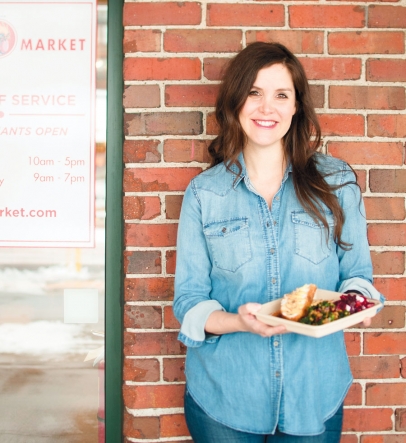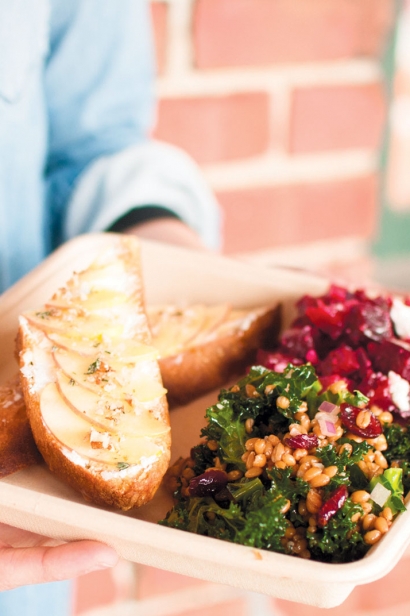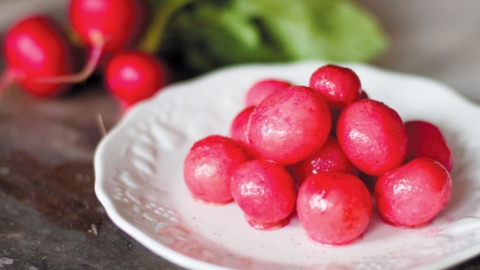The Vegetable Butcher
Little Eater’s Cara Mangini gives veggies a star turn: at her restaurant, at her grocery and in a new cookbook
Produce inspired. This mantra is the touchstone of Cara Mangini’s modest but thriving vegetable empire, which began with Little Eater, a two-day-a-week pop-up eatery, then morphed into both a restaurant and a grocery at North Market, followed by a new cookbook—all in just four short years.
So how did this California girl/New York career woman/vegetable advocate end up in the heart of Ohio?
Let me tell you.
Butcher’s Block & Produce Cart
Dark-haired, 30-something Cara fairly glows with health, a real-life advertisement for the vegetables she loves to eat. Her destiny as a vegetable butcher may have been written into her genes—both grandfathers and a great-grandfather were butchers and produce peddlers, and “Mangini” translates roughly to “little eater.”
Cara’s 93-year-old Italian great-grandmother still cooks Christmas dinner for the extended family, which says it all for Cara where food is concerned. “Meals are where life happens,” she says.
Still, her career began not with food, but with a journalism degree from Northwestern University and travel writing for the Chicago Tribune and Condé Nast publishing. Then it detoured to New York City in 2002 for a 10-year stint as an Estée Lauder executive.
In her spare time, Cara took classes like recipe writing, food writing and cooking, and traveled to Italy, Turkey and France—countries whose food cultures included delicious ways with vegetables.
In 2010, she assumed a secret identity by night: chef-in-training at the National Gourmet Institute.
Her new dream was culinary, so in July 2011, she took the “really, really scary” step of leaving her job. For 18 months, she grew, prepped and cooked vegetables in an odyssey that stretched from NYC to Napa Valley, as she mulled over the practicalities of creating a produce-based business.
Serendipity
Where to grow her new business? Vegetables and her family were in California. Her apartment and her business network were in New York. Then in January 2012, she chanced upon a Jeni’s Splendid Ice Creams booth at a food show in San Francisco. It was manned by a Jeni’s partner, Tom Bauer.
“I had never heard of Jeni until a mentor showed me her ice cream cookbook, which I gave to my family members for Christmas that year,” Cara says. “I didn’t expect to see her booth there.”
Tom offered Cara ice cream samples. They talked about business development and exchanged cards. When Tom’s trip home was serendipitously delayed, they convened a business lunch, and Tom suggested that Cara consider moving to Columbus. Six months and several visits to Ohio later, she did. Two weeks later, Little Eater popped up.
In June 2015, Cara and Tom married, an event bookended by the opening of Little Eater restaurant in February and Little Eater grocery in July.
Love or business acumen? Cara credits “my husband’s support and understanding of the food business and its long hours” and Columbus’s “really incredible community of farmers” to her success here. “I was impressed from the first visit,” she says.
Little Eater
Before opening Little Eater, Cara scouted local farmers markets, where she introduced herself to organic farmers, sampled their wares and learned what and how much they could supply. She chose 10 main farmer suppliers, augmented by about 10 others who supply seasonally. Ten more supply maple syrup, honey, grains, cheeses and breads.
Today Little Eater flourishes at North Market, where its shiny white tiles cover walls and serving counters for a minimalist décor that showcases the bright colors of the vegetables. “I wanted a modern feel, an aesthetic and environment that welcomes everyone,” Cara says.
She cringes at the notion that people eat vegetables only because they are healthy. “I want people to recognize the excitement in vegetable ingredients. There are no labels on it. It’s about everyday eating.”
Multiple visits to Little Eater revealed a varied demographic, all eager for those vegetables. According to customer Mary Blazer: “Everything tastes really good and I know it’s good for me, and it’s local and I honor that. The food never disappoints.”
Seven vegetable salads anchor the menu, flaunting their colors in white ceramic serving dishes. The green salad (mixed greens, carrots, radish, bulgur, chickpeas, cranberries, feta and citrus vinaigrette) and the kale salad (kale, walnuts, spelt berries, cranberries, thyme and lemon) are perennials, with other salads rotating in and out seasonally.
The happy diner can combine a scoop or more of salad with a sandwich, a frittata or quiche, a sweet or savory crostini, a cup of soup—or chow down on salads alone. Little Eater also offers buttermilk cheddar biscuits, apple and granola yogurt parfait and cookies.
All is a joy to the eye as well as to the palate.
Little Eater Produce & Provisions
The departure of Michael Jones’s The Greener Grocer from North Market left a produce void that Cara felt compelled to fill. “It’s a hard business,” Cara acknowledges. “But I believe so much in the Market as a place to showcase Ohio. And it’s another way to support our farm partners.”
The grocery works with about 20 farms and close to 20 Ohio artisan food producers to highlight local produce and pantry items as well as more far-flung foods that Cara describes as “a mix of basic with artisan.”
Little Eater’s trademark shiny white tile and natural wood showcase seasonal produce on a farm table in front, and the counter is designed for cooking demos, dinners and demonstrations of the knife skills that every aspiring vegetable chef needs.
Vegetable Ed
Cara worked as a vegetable butcher in Mario Batali’s Eataly for six months, slicing and dicing, but more importantly, educating her customers about vegetables. She adopted the term for her cookbook, which she wrote and researched for three years.
At Eataly, she learned that many people are uncomfortable with vegetables. Her goal with The Vegetable Butcher was to “take out the intimidating parts of working with vegetables.”
“The book doesn’t assume you already know about vegetables. I learned in years of working with the public that they don’t know.”
The first 20 pages are devoted to basics: vegetable selection, storage and prep; knife selection, care and use, followed by a dictionary of vegetables from artichoke to zucchini; 250 color photos illustrate each step as Cara demystifies vegetable butchery.
But there’s more than chopping and peeling, with each veggie explained in terms of good partners (spices or other foods); selection; storage; varieties; prep; favorite cooking methods; and recipes.
The Vegetable Butcher can rescue the novice who has just purchased a scary new vegetable at the farmers market—or the experienced cook who yearns for a little inspiration for preparing that bunch of carrots.
Growing & Growing
Little Eater’s growth has been rapid, but Cara Mangini’s mission has just begun. She finds the 450 square feet of Little Eater restaurant a tad “limiting” and would like to expand her dining concept to a full restaurant when the right location presents itself.
“Then we can support more farmers and the health of the community and the environment. Those are really great benefits, but enjoying the food comes first.”
What about a Little Eater cookbook? The Vegetable Butcher contains a “handful” of the restaurant’s recipes, but they deserve a cookbook all their own. “I’d love to someday do that,” Cara says.
Reach Cara or her business here.
Restaurant: 614-6704375.
Grocery: 614-947-7483.









